This study explores the efficacy of Non-Negative Matrix Factorization (NMF) for feature selection in high-dimensional cancer data from DNA microarray and methylation datasets, achieving a classification accuracy of 98%. It compares NMF with other dimensionality reduction techniques, particularly Principal Component Analysis (PCA), and evaluates multiple classifiers to determine optimal performance. The findings suggest that NMF effectively reduces dimensionality while retaining critical information, thereby enhancing cancer prediction models.
![International Journal of Data Mining & Knowledge Management Process (IJDKP) Vol.10, No.4, July 2020
DOI:10.5121/ijdkp.2020.10401 1
EFFICACY OF NON-NEGATIVE MATRIX
FACTORIZATION FOR FEATURE SELECTION IN
CANCER DATA
Parth Patel1
, Kalpdrum Passi1
and Chakresh Kumar Jain2
1
Department of Mathematics and Computer Science, Laurentian University,
Sudbury, Ontario, Canada
2
Department of Biotechnology, Jaypee Institute of Information Technology, Noida, India
ABSTRACT
Over the past few years, there has been a considerable spread of microarray technology in many
biological patterns, particularly in those pertaining to cancer diseases like leukemia, prostate, colon
cancer, etc. The primary bottleneck that one experiences in the proper understanding of such datasets lies
in their dimensionality, and thus for an efficient and effective means of studying the same, a reduction in
their dimension to a large extent is deemed necessary. This study is a bid to suggesting different algorithms
and approaches for the reduction of dimensionality of such microarray datasets.This study exploits the
matrix-like structure of such microarray data and uses a popular technique called Non-Negative Matrix
Factorization (NMF) to reduce the dimensionality, primarily in the field of biological data. Classification
accuracies are then compared for these algorithms.This technique gives an accuracy of 98%.
KEYWORDS
Microarray datasets, Feature Extraction, Feature Selection, Principal Component Analysis, Non-negative
Matrix Factorization, Machine learning.
1. INTRODUCTION
There has been an exponential growth in the amount and quality of biologically inspired data
which are sourced from numerous experiments done across the world. If properly interpreted and
analyzed, these data can be the key to solving complex problems related to healthcare. One
important class of biological data used for analysis very widely is DNA microarray data, which is
a commonly used technology for genome-wide expression profiling [1]. The microarray data is
stored in the form of a matrix with each row representing a gene and columns representing
samples, thus each element shows the expression level of a gene in a sample [2]. Gene expression
is pivotal in the context of explaining most biological processes. Thus, any change within it can
alter the normal working of a body in many ways and they are key to mutations [3]. Thus,
studying microarray data from DNA can be a potential method for the identification of many
ailments within human beings, which are otherwise hard to detect. However, due to the large size
of these datasets, the complete analysis of microarray data is very complex [4]. This requires
some initial pre-processing steps for reducing the dimension of the datasets without losing
information.](https://image.slidesharecdn.com/10420ijdkp01-200814153258/75/EFFICACY-OF-NON-NEGATIVE-MATRIX-FACTORIZATION-FOR-FEATURE-SELECTION-IN-CANCER-DATA-1-2048.jpg)
![International Journal of Data Mining & Knowledge Management Process (IJDKP) Vol.10, No.4, July 2020
2
Modern technology has made it possible to gather genetic expression data easier and cheaper
from microarrays. One potential application for this technology is in identifying the presence and
stage of complex diseases within an expression. Such an application is discussed further in this
study
This study, reflects upon the Non-Negative Matrix Factorization (NMF) technique which is a
promising tool in cases of fields with only positive values and assess its effectiveness in the
context of biological and specifically DNA microarray and methylation data. The results obtained
are also compared with the Principal Component Analysis (PCA) algorithm to get relative
estimates.
Motivation for the proposed work was two-fold, first, to test the use of Non-negative Matrix
Factorization (NMF) as a feature selection method on microarray and methylation datasets and
optimize the performance of the classifiers on reduced datasets. Although several feature
selection methods, e.g. Principal Component Analysis (PCA), and others have been used in
literature, there is limited use and testing of matrix factorization techniques in the domain of
microarray and methylation datasets.
2. RELATED WORK
Extensive presence of DNA microarray data has resulted in undertaking lots of studies related to
the analysis of these data, and their relation to several diseases, particularly cancer. The ability of
DNA microarray data over other such data lies in the fact that this data can be used to track the
level of expressions of thousands of genes. These methods have been widely used as a basis for
the classification of cancer.
Golub et al. proposed in [5] a mechanism for the identification of new cancer classes and the
consecutive assignment of tumors to known classes. In the study, the approach of gene
expression monitoring from DNA microarray was used for cancer classification and was applied
to an acute leukemia dataset for validation purposes.
Ramaswamy et al. [6] presented a study of 218 different tumor samples, which spanned across 14
different tumor types. The data consisted of more than 16000 genes and their expression levels
were used. A support vector machine (SVM)-based algorithm was used for the training of the
model. For reducing the dimensions of the large dataset, a variational filter was used which in its
truest essence, excluded the genes which had marginal variability across different tumor samples.
On testing and validating the classification model, an overall accuracy of 78% was obtained,
which even though was not considered enough for confident predictions, but was rather taken as
an indication for the applicability of such studies for the classification of tumor types in cancers
leading to better treatment strategies.
Wang et al. [7] provided a study for the selection of genes from DNA microarray data for the
classification of cancer using machine learning algorithms. However, as suggested by
Koschmieder et al. in [4], due to the large size of such data, choosing only relevant genes as
features or variables for the present context remained a problem. Wang et al. [12] thus
systematically investigated several feature selection algorithms for the reduction of
dimensionality. Using a mixture of these feature selections and several machine learning
algorithms like decision trees, Naive Bayes etc., and testing them on datasets concerning acute
leukemia and diffuse B-cell lymphoma, results that showed high confidence were obtained.
Sorlie et al. [8] performed a study for the classification of breast carcinomas tumors using genetic
expression patterns which were derived from cDNA microarray experiments. The later part of the](https://image.slidesharecdn.com/10420ijdkp01-200814153258/75/EFFICACY-OF-NON-NEGATIVE-MATRIX-FACTORIZATION-FOR-FEATURE-SELECTION-IN-CANCER-DATA-2-2048.jpg)
![International Journal of Data Mining & Knowledge Management Process (IJDKP) Vol.10, No.4, July 2020
3
study also studied the clinical effects and implications of this by correlating the characteristics of
the tumors to their respective outcomes. In the study, 85 different instances were studied which
constituted of 78 different cancers. Hierarchical clustering was used for classification purposes.
The obtained accuracy was about 75% for the entire dataset, and by using different sample sets
for testing purposes.
Liu et al. [9] implemented an unsupervised classification method for the discovery of classes
from microarray data. Their study was based on previous literature and the common application
of microarray datasets which identified genes and classified them based on their expression
levels, by assigning a weight to each individual gene. They modeled their unsupervised algorithm
based on the Wilcoxon rank sum test (WT) for the identification and discovery of more than two
classes from gene data.
Matrix Factorization (MF) is an unprecedented class of methods that provides a set of legal
approaches to identify low-dimensional structures while retaining as much information as
possible from the source data [22]. MF is also called matrix factorization, and the sequence
problem is called discretization [22]. Mathematical and technical descriptions of the MF
methods[19] [20], as well as microarray data [21] for their applications, are found in other
reviews. Since the advent of sequencing technology, we have focused on the biological
applications of MF technology and the interpretation of its results. [22] describes various MF
methods used to analyze high-throughput data and compares the use of biological extracts from
bulk and single-cell data. In our study we used specific samples and patterns for best
visualization and accuracy.
Mohammad et al. [18] introduced a variational autoencoder (VAE) for unsupervised learning for
dimensionality reduction in biomedical analysis of microarray datasets. VAE was compared with
other dimensionality reduction methods such as PCA (principal components analysis), fastICA
(independent components analysis), FA (feature analysis), NMF and LDA (latent Dirichlet
allocation). Their results show an average accuracy of 85% with VAE and 70% with NMF for
leukemia dataset whereas our experiments provide 98% accuracy with NMF. Similarly, for colon
dataset, their results show an average accuracy of 68% with NMF and 88% with VAE whereas
our experiments provide 90% accuracy with NMF.
2.1. Contributions
1. Two different types of high dimensional datasets were used, DNA Microarray Data
(Leukemia dataset, prostate cancer dataset, colon cancer dataset) and DNA methylation
Data (Oral cancer dataset, brain cancer dataset)
2. Two different feature extraction methods, NMF and PCA were applied for
dimensionality reduction on datasets with small sample size and high dimensionality
using different classification techniques (Random Forest, SVM, K-nearest neighbor,
artificial neural networks).
3. All the parameters were tested for different implementations of NMF and classifiers and
the best parameters were used for selecting the appropriate NMF algorithm.
4. Computing time Vs. number of iterations were compared for different algorithms using
GPU and CPU for the best performance.
5. Results demonstrate that NMF provides the optimum features for a reduced
dimensionality and gives best accuracy in predicting the cancer using various classifiers.](https://image.slidesharecdn.com/10420ijdkp01-200814153258/75/EFFICACY-OF-NON-NEGATIVE-MATRIX-FACTORIZATION-FOR-FEATURE-SELECTION-IN-CANCER-DATA-3-2048.jpg)
![International Journal of Data Mining & Knowledge Management Process (IJDKP) Vol.10, No.4, July 2020
4
3. MATERIAL AND METHODS
3.1. Datasets
As a part of this study, five datasets relating to cancer were analyzed of which three are
microarray datasets and two are methylation datasets. The aim of using methylation dataset is to
ascertain the impact of DNA methylation on cancer development, particularly in the case of
central nervous system tumors. The Prostate Cancer dataset contains a total of 102 samples and
2135 genes, out of which 52 expression patterns were tumor prostate specimens and 50 were
normal specimens [6]. The second dataset used as a part of this study is a Leukemia microarray
dataset [5]. This dataset contains a total of 47 samples, which are all from acute leukemia
patients. All the samples are either acute lymphoblastic leukemia (ALL) type or of the acute
myelogenous leukemia (AML) type. The third dataset used is a Colon Cancer microarray Dataset
[11]. This dataset contains a total of 62 samples, out of which 40 are tumor samples and the
remaining 22 are from normal colon tissue samples. The dataset contained the expression
samples for more than 2000 genes having the highest minimal intensity for a total of 62 tissues.
The ordering of the genes was placed in decreasing order of their minimal intensities. The fourth
and fifth dataset are the brain cancer and the oral cancer dataset with extensive DNA methylation
observed [10]. the cancer methylation dataset is a combination of two types of information which
are the acquired DNA methylation changes and the characteristics of cell origin. It is observed
that such DNA methylation profiling is highly potent for the sub-classification of central nervous
system tumors even in cases of poor-quality samples. The datasets are extensive with over 180
columns and 21000 rows denoting different patient cases. Classification is done using 1 for
positive and 0 for negative instances.
3.2. Feature Selection
In the field of statistics and machine learning, feature reduction refers to the procedure for
reducing the number of explanatory (independent) columns from the data under consideration. It
is important in order to reduce the time and computational complexity of the model while also
improving the robustness of the dataset by removal of correlated variables. In some cases, such as
in the course of this study, it also leads to better visualization of the data.
Some of the popular feature reduction techniques include Principal Component Analysis (PCA),
Non-negative Matrix Factorization (NMF), Linear Discriminant Analysis (LDA), autoencoders,
etc.
In this study, we analyze Non-negative Matrix Factorization (NMF) technique for feature
selection and test the effectiveness in the context of biological and specifically DNA microarray
and methylation data and compare our results with the PCA algorithm to get relative estimates.
3.2.1. Non-negative Matrix Factorization (NMF)
Kossenkov et al. [2] suggests the use of several matrix factorization methods for the same
problem. The method presented in the paper is a Non-negative Matrix Factorization (NMF)
technique which has been used for dimensionality reduction in numerous cases [5].
For a random vector X with (m x n) dimensions, the aim of NMF is to try to express this vector X
in terms of a basis matrix U (m x l) dimension and a coefficient matrix V (l x n) dimension, i.e.:
X ≈ UV
The initial condition being L << min (m, n).](https://image.slidesharecdn.com/10420ijdkp01-200814153258/75/EFFICACY-OF-NON-NEGATIVE-MATRIX-FACTORIZATION-FOR-FEATURE-SELECTION-IN-CANCER-DATA-4-2048.jpg)
![International Journal of Data Mining & Knowledge Management Process (IJDKP) Vol.10, No.4, July 2020
5
Here U and V are m x l and l x n dimensional matrices with positive values. U is known as the
basis matrix while V is the coefficient matrix. The idea behind this algorithm is to obtain values
of U and V such that the following function is at its local minima:
𝑚𝑖𝑛[𝐷(𝑋, 𝑈𝑉) + 𝑅(𝑈, 𝑉)]
where D: distance cost function, R: regularization function.
Results show that the obtained matrix U has a high dimension reduction from X.
On the application of the NMF algorithms, similar to other dimensionality reduction algorithms, a
large number of variables are clustered together. In the case of NMF, expression data from the
genes are reduced to form a small number of meta-genes [13]. For the matrix U, each column
represents a metagene and the values give the contribution for the gene towards that metagene.
The working of an NMF algorithm on a microarray dataset is shown in the Figure 1 with each
pixel indicating the expression values (shown in the form of the intensity of colors).
After subsequent NMF based dimensionality reduction is done, the obtained reduced matrix is
expected to contain the same information as the original matrix. In order to check the validity of
the above assumption, classification algorithms are applied to the reduced matrix and
subsequently, their accuracies were measured. Another popular dimensionality reduction
technique which is the Principal Component Analysis (PCA) is used and then compared with the
proposed NMF based models. It must be emphasized that conventional NMF based algorithms,
even though very accurate are highly resource intensive when used for large datasets. This study,
therefore, also makes use of certain GPU algorithms in order to effectively evaluate the same,
making training time much more feasible.
Figure 1. Image showing how an NMF algorithm is used to get a basis matrix of rank (2) [13]
There are different implementations of the NMF which are categorized based on the choice for
the loss function (D) and the regularization function (R). The implementations used in this study
are listed below.
Non-smooth NMF (nsNMF) [14]
Kullback Leibler Method (KL) [13]
Frobenius [15]
Offset [15]](https://image.slidesharecdn.com/10420ijdkp01-200814153258/75/EFFICACY-OF-NON-NEGATIVE-MATRIX-FACTORIZATION-FOR-FEATURE-SELECTION-IN-CANCER-DATA-5-2048.jpg)
![International Journal of Data Mining & Knowledge Management Process (IJDKP) Vol.10, No.4, July 2020
6
Multiplicative Update Algorithm (MU) [15]
Alternating Least Square (ALS) [16]
Alternating Constrained Least Square (ACLS) [17]
Alternating Hoyer Constrained Least Square (AHCLS) [17]
Gradient Descent Constrained Least Square (GDCLS) [15]
3.2.2. Principal Component Analysis (PCA)
PCA is a widely used technique in the field of data analysis, for orthogonal transformation-based
feature reduction on high-dimensional data. Using PCA, a reduced number of orthogonal
variables can be obtained which explain the maximum variation within the data. Using a reduced
number of variables helps in significant reduction in computational cost and runtimes while still
containing a high amount of information as within the original data.
It is a widely used tool throughout the field of analytics for feature reduction before predictive
modelling. The steps involved in the computation of a PCA algorithm is shown below:
Let ‘X’ be the initial matrix of dimension (m x n), where m = number of rows, and n is the
number of columns.
The first step is to linearly transform the matrix X into a matrix B such that,
B = Z * X
where, Z is a matrix of order (m x m).
The second step is to normalize the data. In order to normalize, the mean for the data is computed
and normalization is done by subtracting off the mean for finding out the principal components.
The equations are shown below:
𝑀(𝑚) = 1/𝑁 ∑ 𝑋[𝑚, 𝑛]𝑁
𝑛=1 , 𝑋′
= 𝑋 − 𝑀
The next step involves computing the covariance matrix of X, which is computed as below
𝐶𝑋 = 𝑋 ∗
𝑋 𝑇
(𝑛 − 1)
In the covariance matrix, all diagonal elements represent the variance while all non-diagonal
elements represent co-variances.
The covariance equation for B is shown below
𝐶 𝐵 = 𝐵 ∗
𝐵 𝑇
(𝑛−1)
=
(𝑍𝐴)(𝑍𝐴) 𝑇
(𝑛−1)
=
(𝑍𝐴)(𝐴 𝑇∗𝑍 𝑇)
(𝑛−1)
=
𝑍𝑌∗𝑍 𝑇
(𝑛−1)
where 𝑌 = 𝐴 ∗ 𝐴 𝑇
, and of dimension (m x m),
Now, Y can be further expressed in the form, Y = EDE, where E is an orthogonal matrix whose
columns represent the eigenvalues of Y, while D is a diagonal matrix with the eigenvalues as its
entries.
If Z = 𝐸 𝑇
, the value of covariance for B becomes,](https://image.slidesharecdn.com/10420ijdkp01-200814153258/75/EFFICACY-OF-NON-NEGATIVE-MATRIX-FACTORIZATION-FOR-FEATURE-SELECTION-IN-CANCER-DATA-6-2048.jpg)
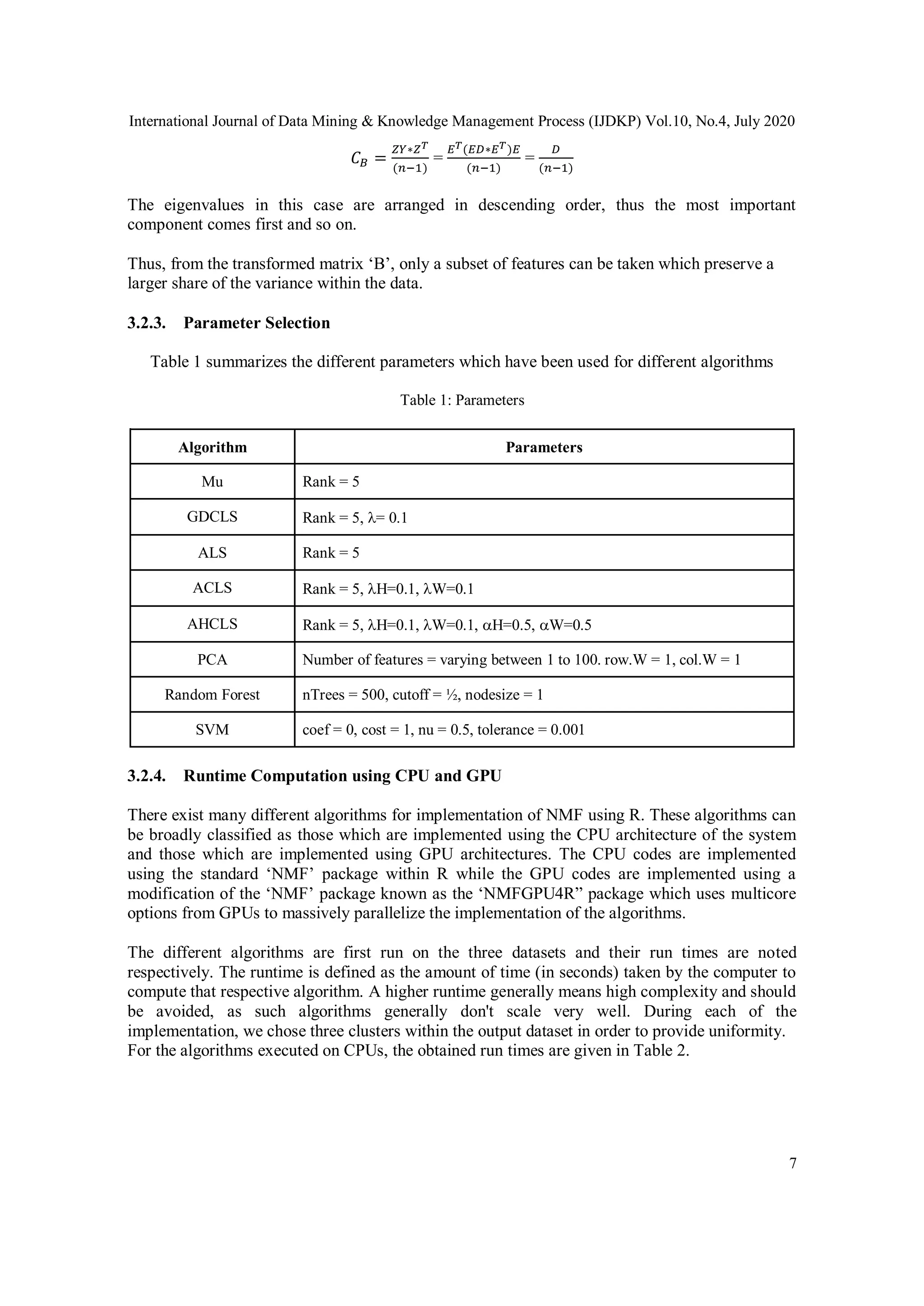
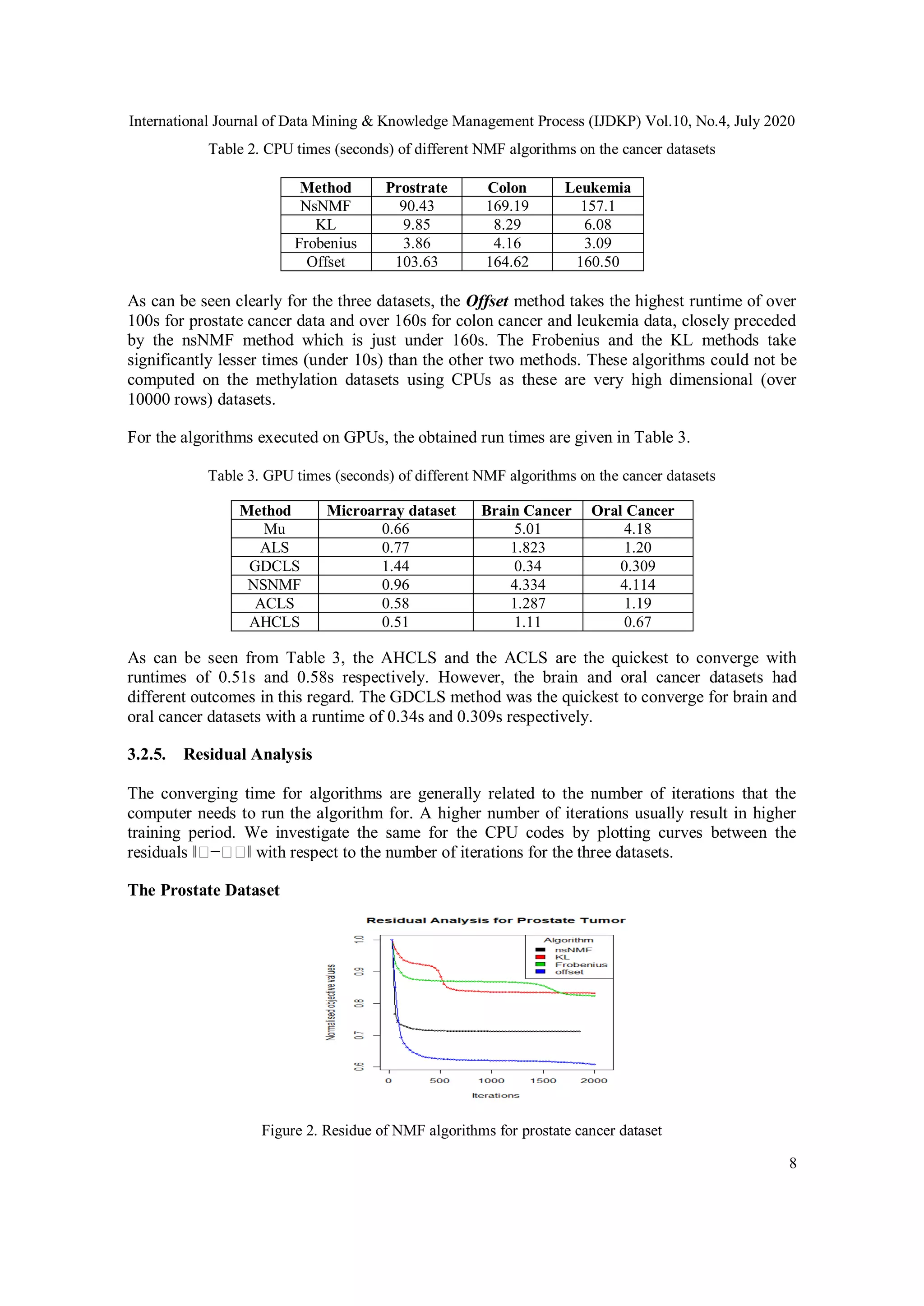

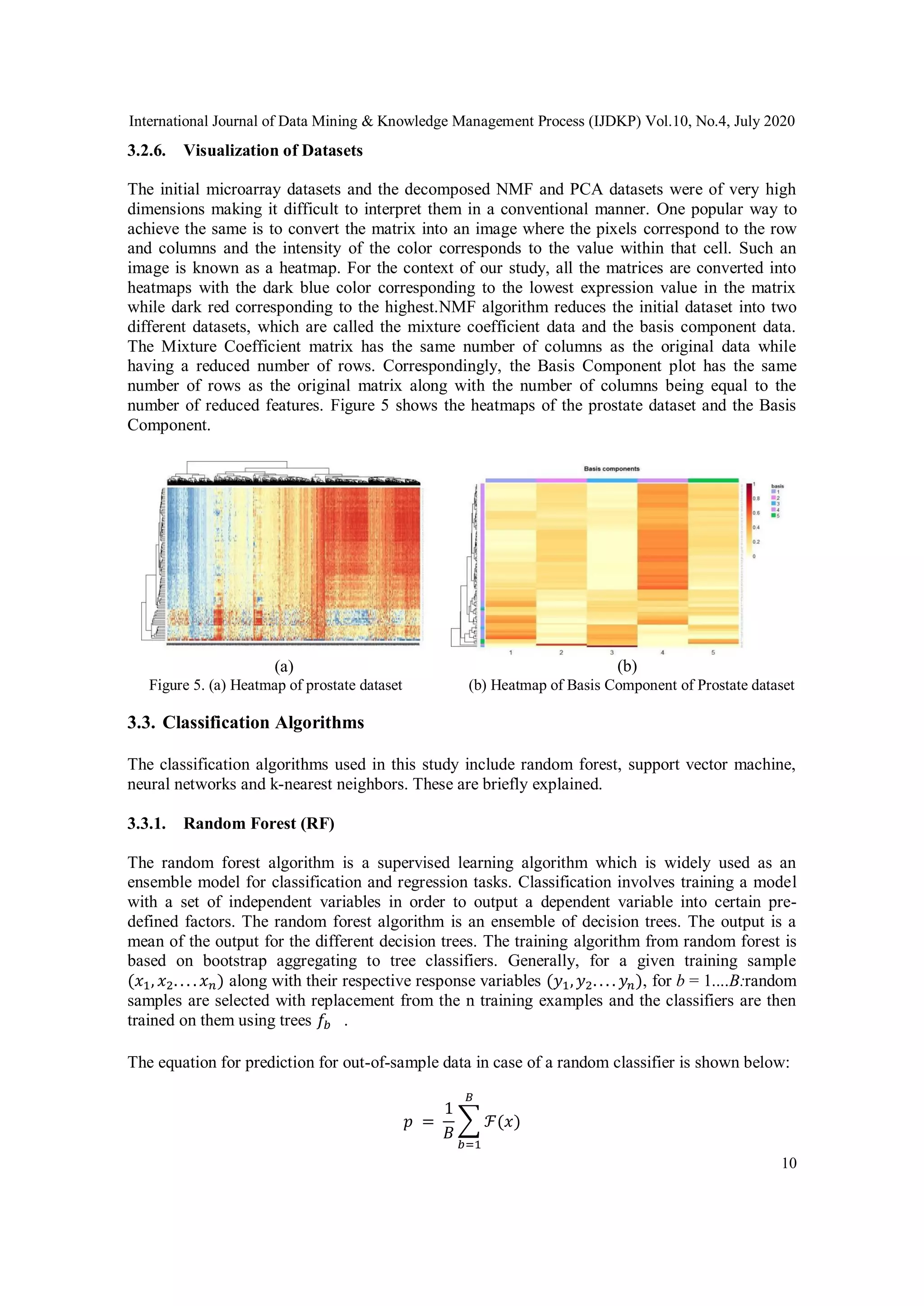
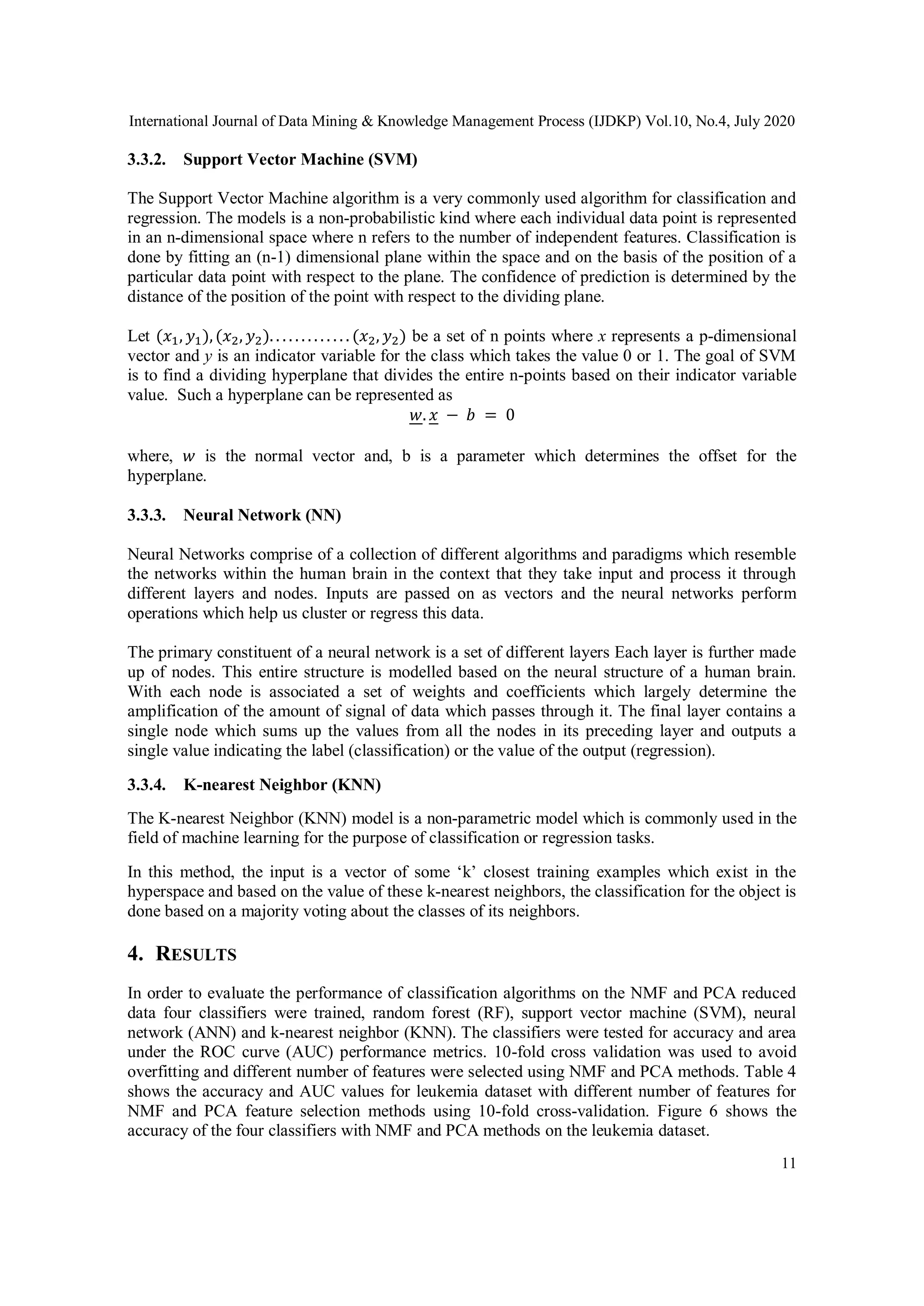

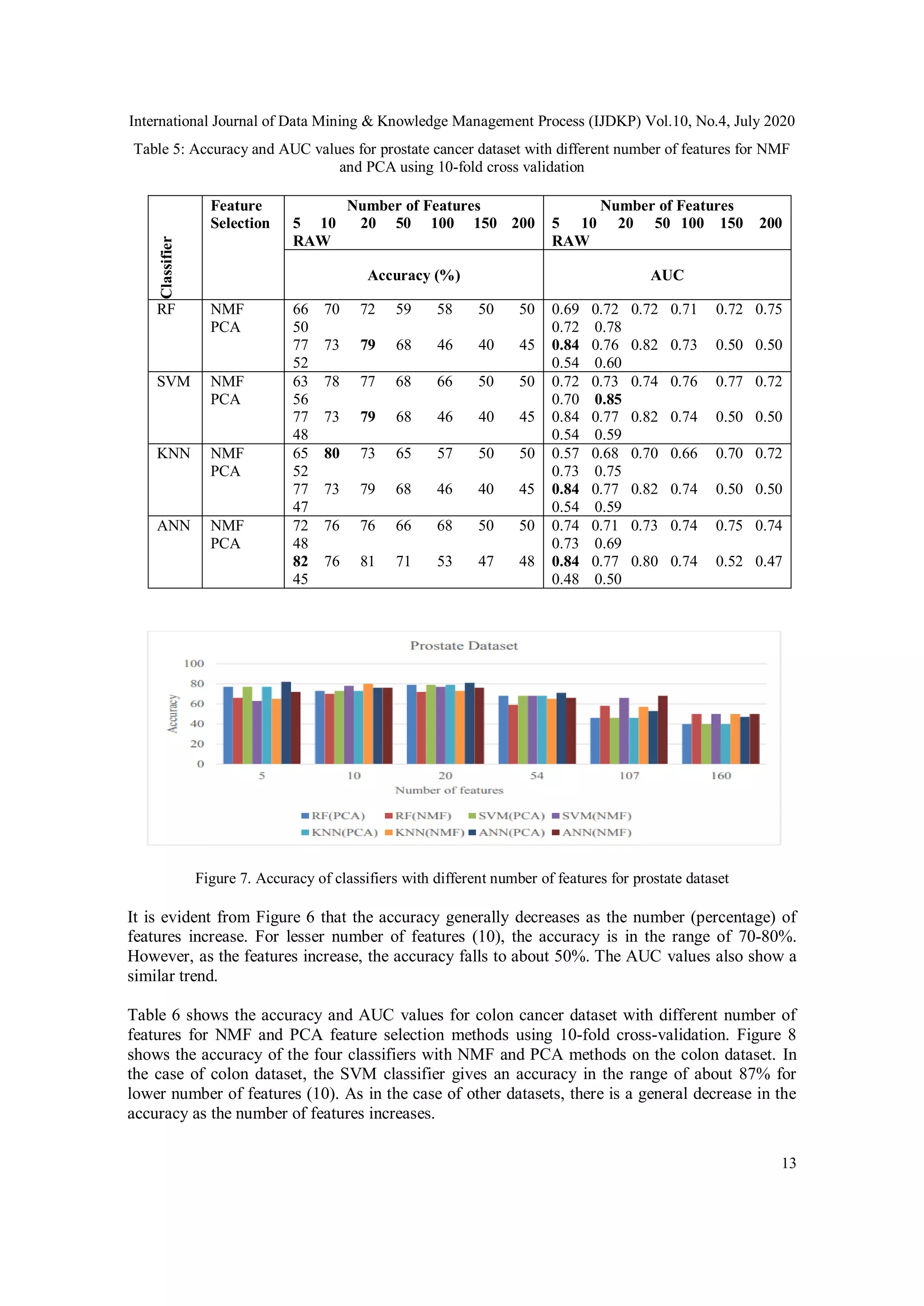



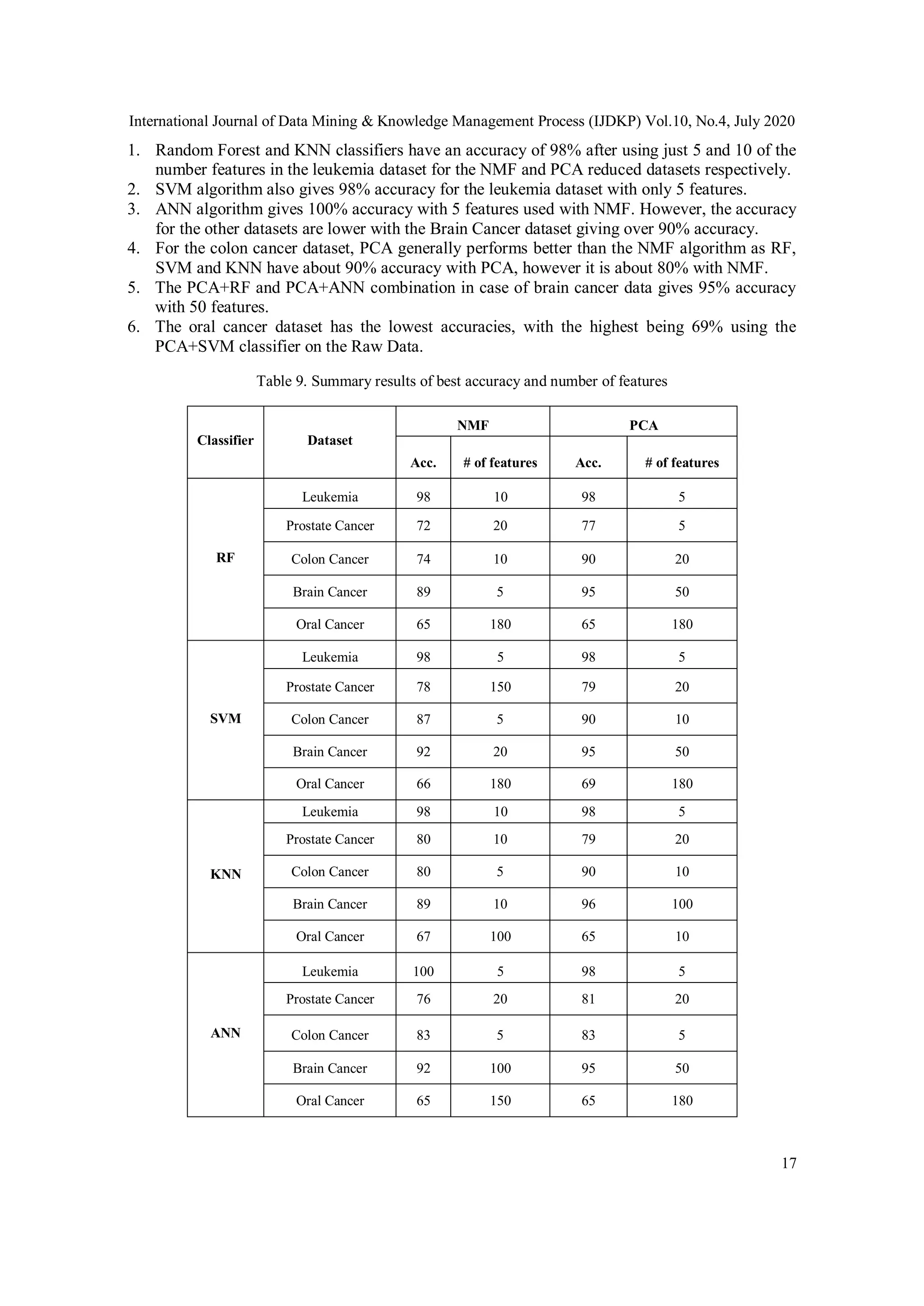

![International Journal of Data Mining & Knowledge Management Process (IJDKP) Vol.10, No.4, July 2020
19
REFERENCES
[1] SinghA., "Microarray Analysis of the Genome-Wide Response to Iron Deficiency and Iron
Reconstitution in the Cyanobacterium SynchroSystems sp. PCC 6803", PLANT PHYSIOLOGY, vol.
132, no. 4, pp. 1825-1839, 2003. Available: 10.1104/pp.103.024018.
[2] Kossenkov A. andOchs M, "Matrix factorization methods applied in microarray data analysis",
International Journal of Data Mining and Bioinformatics, vol. 4, no. 1, p. 72, 2010. Available:
10.1504/ijdmb.2010.030968.
[3] Nott, D.,Yu, Z., Chan, E., Cotsapas, C., Cowley, M., Pulvers, J., Williams, R.,and Little, P.,
"Hierarchical Bayes variable selection and microarray experiments", Journal of Multivariate Analysis,
vol. 98, no. 4, pp. 852-872, 2007. Available: 10.1016/j.jmva.2006.10.001.
[4] Koschmieder A., Zimmermann K., Trissl S., StoltmannT., and Leser U., "Tools for managing and
analyzing microarray data", Briefings in Bioinformatics, vol. 13, no. 1, pp. 46-60, 2011. Available:
10.1093/bib/bbr010.
[5] Golub T., "Molecular Classification of Cancer: Class Discovery and Class Prediction by Gene
Expression Monitoring", Science, vol. 286, no. 5439, pp. 531-537, 1999. Available:
10.1126/science.286.5439.531.
[6] Ramaswamy, S., Tamayo, P., Rifkin, R., Mukherjee, S., Yeang, C. H., Angelo, M., Ladd, C., Reich,
M., Latulippe, E., Mesirov, J. P., Poggio, T., Gerald, W., Loda, M., Lander, E. S., & Golub, T. R.
(2001). “Multiclass cancer diagnosis using tumor gene expression signatures”. Proceedings of the
National Academy of Sciences of the United States of America, volume 98, no. 26, pp. 15149–15154.
https://doi.org/10.1073/pnas.211566398
[7] Wang, Z., Liang, Y., Chijun Li., Yunyuan ,Xu., Lefu Lan., Dazhong Z.,Changbin C., Zhihong Xu.,
Yongbiao Xue.,and Kang, C., (2005). "Microarray Analysis of Gene Expression Involved in Another
Development in rice (Oryza sativa L.)", Plant Molecular Biology, vol. 58, no. 5, pp. 721-737, 2005.
Available: 10.1007/s11103-005-8267-4.
[8] Therese Sørlie, Charles M. Perou, Robert Tibshirani, Turid Aas, Stephanie Geisler, Hilde Johnsen,
Trevor Hastie, Michael B. Eisen, Matt van de Rijn, Stefanie S. Jeffrey, Thor Thorsen, Hanne Quist,
John C. Matese, Patrick O. Brown, David Botstein, Per Eystein Lønning, and Anne-Lise Børresen-
Dale, "Gene expression patterns of breast carcinomas distinguish tumor subclasses with clinical
implications", Proceedings of the National Academy of Sciences, vol. 98, no. 19, pp. 10869-10874,
2001. Available: 10.1073/pnas.191367098.
[9] Liu-Stratton y., Roy S.,and Sen C., "DNA microarray technology in nutraceutical and food safety",
Toxicology Letters, vol. 150, no. 1, pp. 29-42, 2004. Available: 10.1016/j.toxlet.2003.08.009.
[10]Capper, D., Jones, D., Sill, M., Hovestadt, V., Schrimpf, D., Sturm, D., Koelsche, C., Sahm, F.,
Chavez, L., Reuss, D. E., Kratz, A., Wefers, A. K., Huang, K., Pajtler, K. W., Schweizer, L., Stichel,
D., Olar, A., Engel, N. W., Lindenberg, K., Harter, P. N., … Pfister, S. M. (2018). DNA methylation-
based classification of central nervous system tumours. Nature, vol.555, no. (7697), pp. 469–474.
https://doi.org/10.1038/nature26000
[11]Alon, U., Barkai, N., D. A. Notterman, K. Gish, S. Ybarra, D. Mack, and A. J. Levine, "Broad patterns
of gene expression revealed by clustering analysis of tumor and normal colon tissues probed by
oligonucleotide arrays", Proceedings of the National Academy of Sciences, vol. 96, no. 12, pp. 6745-
6750, 1999. Available: 10.1073/pnas.96.12.6745.
[12]Wang, j., Wang X., and Gao X., "Non-negative matrix factorization by maximizing correntropy for
cancer clustering", BMC Bioinformatics, vol. 14, no. 1, p. 107, 2013. Available: 10.1186/1471-2105-
14-107.
[13]Brunet, j., Tamayo, p., GolubT., and Mesirov, j., “Metagenes and molecular pattern discovery using
matrix factorization", Proceedings of the National Academy of Sciences, vol. 101, no. 12, pp. 4164-
4169, 2004. Available: 10.1073/pnas.0308531101.
[14]Pascual-Montano, A., Carazo, J., Kochi, K., Lehmann Dand Pascual-Marqui., A, "Non-smooth
nonnegative matrix factorization (nsNMF)", IEEE Transactions on Pattern Analysis and Machine
Intelligence, vol. 28, no. 3, pp. 403-415, 2006. Available: 10.1109/tpami.2006.60
[15]Févotte C and Idier J, "Algorithms for Nonnegative Matrix Factorization with the β-Divergence",
Neural Computation, vol. 23, no. 9, pp. 2421-2456, 2011. Available: 10.1162/neco_a_00168](https://image.slidesharecdn.com/10420ijdkp01-200814153258/75/EFFICACY-OF-NON-NEGATIVE-MATRIX-FACTORIZATION-FOR-FEATURE-SELECTION-IN-CANCER-DATA-19-2048.jpg)
![International Journal of Data Mining & Knowledge Management Process (IJDKP) Vol.10, No.4, July 2020
20
[16]Paatero,P. and Tapper,U., "Positive matrix factorization: A non-negative factor model with optimal
utilization of error estimates of data values", Environ metrics, vol. 5, no. 2, pp. 111-126, 1994.
Available: 10.1002/env.3170050203
[17]A. N. Langville, C. D. Meyer, Albright, R.,Cox, J., and Duling, D., "Algorithms, initializations, and
convergence for the nonnegative matrix factorization", CoRR, vol. abs/1407.7299, 2014.
[18]Mohammad Sultan Mahmud, Xianghua Fu,Joshua Zhexue Huang and Md.Abdul Masud "Biomedical
Data Classification Using Variational Autoencoder ", @ Springer Nature Singapore pte Ltd.2019
R.Islam et al(Eds): Aus DM 2018 CCIS 996, pp.30-42,2019.
[19]Ochs MF and Fertig EJ (2012) Matrix factorization for transcriptional regulatory network inference.
IEEE Symp. Comput. Intell. Bioinforma. Comput. Biol. Proc 2012, 387–396 [PMC free article]
[PubMed] [Google Scholar]
[20]Yifeng Li, Fang-Xiang Wu, Alioune Ngom,. (2016) A review on machine learning principles for
multi-view biological data integration. Brief. Bioinform 19, 325–340 [PubMed] [Google Scholar]
[21]Devarajan K (2008) Nonnegative matrix factorization: an analytical and interpretive tool in
computational biology. PLoS Com-put. Biol 4, e1000029 [PMC free article] [PubMed] [Google
Scholar]
[22]Stein-O’Brien, Genevieve., Arora, Raman., Culhane, Aedin., Favorov, Alexander., Garmire, Lana.,
Greene, Casey., Goff, Loyal., Li, Yifeng., Ngom, Alioune., Ochs, Michael., Xu, Yanxun and Fertig,
Elana. (2018). “Enter the Matrix: Factorization Uncovers Knowledge from Omics.” Trends in
genetics: TIG vol. 34,10 (2018): 790-805. doi: 10.1016/j.tig.2018.07.003.
AUTHORS
Parth Patel graduated from Laurentian University,Ontario, Canada with Master’s
degree in ComputationalSciences. He pursued his bachelor’s degree in
ComputerEngineering from the Gujarat Technological University,Gujarat, India. His
main areas of interest are Machine Learning Techniques, Data Analytics and Data
Optimization Techniques. Hecompleted his M.Sc. thesis in Prediction of Cancer
Microarray and DNA Methylation Data Using Non-Negative Matrix Factorization.
Kalpdrum Passi received his Ph.D. in Parallel Numerical Algorithms from Indian
Institute of Technology, Delhi, India in 1993. He is an Associate Professor,
Department of Mathematics & Computer Science, at Laurentian University, Ontario,
Canada. He has published many papers on Parallel Numerical Algorithms in
international journals and conferences. He has collaborative work with faculty in
Canada and US and the work was tested on the CRAY XMP’s and CRAY YMP’s. He
transitioned his research to web technology, and more recently has been involved in
machine learning and data mining applications in bioinformatics, social media and
other data science areas. He obtained funding from NSERC and Laurentian
University for his research. He is a member of the ACM and IEEE Computer Society.
Chakresh Kumar Jain received his Ph.D. in the field of bioinformatics from Jiwaji
University, Gwalior, India. He is an Assistant Professor, Department of
Biotechnology, Jaypee Institute of Information Technology, Noida, India. He is
CSIR-UGC-NET [LS] qualified and member of International Association of
Engineers (IAENG) and life member of IETE, New Delhi, India. His research
interests include development of computational algorithms for quantification of
biological features to decipher the complex biological phenomenon and diseases
such as cancer and neurodegenerative diseases apart from drug target identification
and mutational analysis for revealing the antibiotic resistance across the microbes
through computer based docking, molecular modelling and dynamics, non-coding
RNAs identification, machine learning, data analytics, and systemsbiology based
approaches.](https://image.slidesharecdn.com/10420ijdkp01-200814153258/75/EFFICACY-OF-NON-NEGATIVE-MATRIX-FACTORIZATION-FOR-FEATURE-SELECTION-IN-CANCER-DATA-20-2048.jpg)